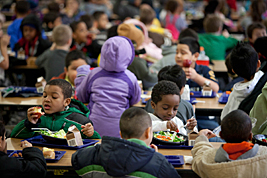Back to School: How Educational Economics is Leading to a Wider Gap Between Rich and Poor
When it comes to educational performance, and socioeconomic mobility in general, these income and gender pay disparities matter. The capacity to spend if not the actual dollars spent on a child's education is linked to his or her educational success. Earlier this year the New York Times reported on a study by Stanford scholar Sean F. Reardon demonstrating that income is tightly related to academic performance. Reardon's study looks in depth at the correlation between income and standardized test performance, finding that that between 1960 and 2007, the gap in standardized test scores between affluent and low-income students had grown by nearly 40 percent.
Minority Enrollment: Black And Hispanic Students Underrepresented At Highly Selective Colleges, Stanford Study Finds
Black and Hispanic students remain significantly underrepresented in the most selective colleges, according to a new report.
The study, released by Stanford University's Center for Education Policy Analysis, analyzed race, income and enrollment patterns at top-tier universities from 1982 to 2004.
No Middle Ground - America’s Growing Income Segregation
It’s no surprise that Americans spend a large share of their incomes to live in the best neighborhoods they can afford. And increasingly our neighbors’ bank accounts are looking more and more like our own.
In 1970 two-thirds of families lived in middle-income neighborhoods; by 2008 only 43 percent of families lived in such neighborhoods. At the same time, the percentage of families who lived in predominantly poor or predominantly affluent neighborhoods increased by more than 60 percent. By 2008 nearly one in three families in U.S. metropolitan areas lived in neighborhoods at the extremes of the local income spectrum.
So should schools focus their resources on the racial achievement gap or the income gap?
Analysis: More Minnesota students relying on free and reduced lunches. So should schools focus their resources on the racial achievement gap or the income gap? Stanford University sociologist Sean Reardon would argue for the income gap. "We've focused a lot on race and I think it's important to keep paying attention to, but I would like to see us increase the amount of attention we're paying to the socio-economic achievement gaps because they're big, they're growing, and they have huge implications for the future workforce and the health of the economy," he said.
A New Take on 'No Excuses' - Tackling Poverty to Provide Meaningful Opportunity
Last week's Capitol Hill briefing by three national experts -- Sean Reardon from Stanford University, Peter Edelman of the Georgetown Law Center, and David Sciarra from the Education Law Center in Newark -- brought the realities of poverty's impact on education into stark relief. Mr. Reardon cited findings from his chapter in the recent Russell Sage compendium Whither Opportunity to demonstrate that our record and growing income gaps, combined with a tattered social safety net, fundamentally threaten the American Dream. Current U.S. education policies compound, rather than alleviate, these massive income disparities, putting equality of opportunity even further out of reach for large numbers of low-income American students.
One way to bridge achievement gap
For the last 50 years, test scores between high-income and low-income children has grown by about 40 percent, according to a study published last year by Sean Reardon, associate professor of education at Stanford University. That gap is nearly twice the size of the achievement gap by student ethnicity, Reardon found.
Education Gap Grows Between Rich and Poor, Studies Say
Education was historically considered a great equalizer in American society, capable of lifting less advantaged children and improving their chances for success as adults. But a body of recently published scholarship suggests that the achievement gap between rich and poor children is widening, a development that threatens to dilute education’s leveling effects.
Education and Inequality
Education has long been the primary pathway to social mobility in the United States. The American Dream—the idea that one’s family origin is no barrier to economic success—is plausible to the extent that we believe that our schools provide all students with equal opportunity to develop skills that will enable them to succeed in our complex society. Without such opportunity, hope for social mobility dims.
So when we ask whether America is becoming more or less equal, we should ask not only whether income and political power are becoming more unequally distributed (they are), but also whether the opportunity for social mobility is declining. We should ask whether children from all backgrounds have equal opportunities to
U.S. income inequality to radicalize politics
Sean Reardon, Associate Professor of Sociology at Stanford University says the growing divide between rich and poor in the U.S. will polarize the political process. He adds the Occupy Wall Street protests are an example of this process.




